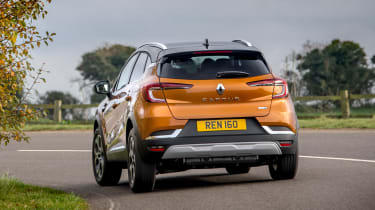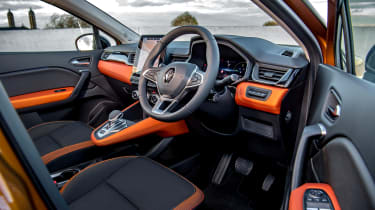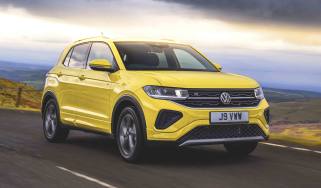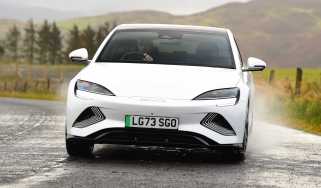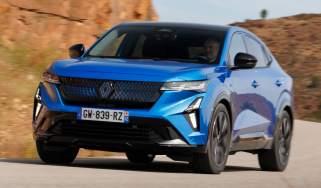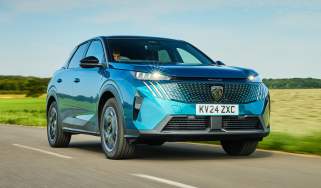New 2020 Renault Captur: prices, engines and specs
The Renault Captur offers buyers a choice of petrol, diesel or plug-in hybrid powertrains – and it’ll be available with a petrol hybrid unit in 2021
Hybrid power is set to form a part of Renault’s second-generation Captur lineup, which will next year join a range which already offers petrol, diesel and plug-in hybrid powertrains.
Next year, Renault will also introduce a full-hybrid version of the Captur. While specific details about the new powertrain are yet to be confirmed, it’s almost certain to be the hybrid setup already used in the Clio E-Tech hybrid. This means a 1.6-litre petrol engine is combined with a series of electric motors, and a 1.2kWh battery allows for short bursts of electric-only driving.
The existing Captur range – which we crowned our Small SUV of the Year at the Auto Express New Car Awards – squares up to rivals such as the Nissan Juke and the Skoda Karoq with a starting price of £19,095.
Standard equipment for the entry-level Renault Captur Play include 17-inch steel wheels, LED headlights, automatic windscreen wipers and a pair of electrically adjustable and heated door mirrors. There’s also a broad range of standard safety equipment, including lane-keeping assist, lane departure warning, active emergency braking, traffic sign recognition, cruise control and a speed limiter.
Inside, buyers get a leather-trimmed steering wheel, fabric upholstery, automatic climate control, a 4.2-inch TFT monitor set into the gauge cluster and a seven-inch infotainment system with support for Apple CarPlay and Android Auto.
The mid-range Renault Captur Iconic starts from £20,595 and adds 17-inch alloy wheels, rear parking sensors, roof bars, two-tone paint and more heavily tinted rear windows. The car’s seven-inch infotainment system gets an upgrade with an integrated sat-nav system.
Renault’s flagship S Edition is priced from £22,095. It builds on the Iconic’s specification with the company’s trademark C-shaped LED daytime running lights, a set of diamond-cut 17-inch alloy wheels, front and rear parking sensors, a blind-spot monitoring system and a shark-fin antenna mounted on the roof.
The cabin gets a lift too, with faux leather upholstery, an auto-dimming rear view mirror, a wireless smartphone charger, a larger 9.3 infotainment system and a seven-inch digital instrument binnacle in place of the standard car’s analogue unit.
With the exception of some extra badges and a larger 10-inch instrument binnacle, Renault’s £30,995 E-Tech plug-in hybrid model shares the same basic equipment as the Captur S Edition. However, the French brand also offers a more generously equipped Launch Edition variant, which features a handful of cosmetic tweaks.
It’s priced from £31,495 and comes with 18-inch alloy wheels, a model-specific white insert for the dashboard, exclusive cloth upholstery with blue stitching and a range of copper and blue inserts for the car’s front bumper, front wing and C-pillar.
Renault’s 10-inch digital gauge cluster can also be specced as a £250 optional extra, along with a range of interior colour customisation packages and Renault’s Traffic and Motorway Assistance Pack (£600), which adds adaptive cruise control, a 360-degree view monitor and a blind spot monitoring system.
New 2020 Renault Captur: E-Tech plug-in hybrid
The second-generation Captur is also available with a new plug-in hybrid powertrain, which has been developed using knowledge gained from the Renault F1 team. The system comprises a naturally aspirated 1.6-litre four-cylinder petrol engine, an integrated starter-generator, a conventional electric motor and a 9.8kWh battery.
The system develops 158bhp and 340Nm of torque and has a maximum all-electric range of 30 miles.The system also features a “Sport” mode, which forces the electric motors and the petrol engine to work in tandem when the throttle is fully depressed.
As is common in most hybrids, Renault’s PHEV starts in pure electric mode, and uses an energy recovery system which can add a little extra charge back into the battery. Official WLTP figures state that the Captur E-Tech Plug-in is capable of delivering economy figures of 188.3mpg and CO2 emissions of 34g/km. However, due to the intrusion of the batteries, boot capacity has dropped from 526 litres to 379 litres.
Like the current Clio E-Tech hybrid, the upcoming Captur hybrid is likely to share its 1.6-litre combustion engine, gearbox and electric motors with the PHEV. However, in place of the bulky plug-in battery sits a more compact 1.2kWh unit. The lower voltage of the standard hybrid’s battery means that it can’t drive as much power into the electric motors – the total system output drops 20bhp to 138bhp as a result – and the smaller capacity means that it covers shorter distances in zero-emission mode.
New 2020 Renault Captur: engine range
The rest of the Captur range is made up of three petrol and two diesel engines. Entry-level cars are fitted with a 1.0-litre three-cylinder TCe petrol engine and a five-speed manual gearbox. The engine produces a maximum output of 99bhp and 160Nm of torque and gives the Captur and claimed fuel economy figure of 47.1mpg.
Above that site a 1.3-litre four-cylinder petrol engine with either 129bhp and 240Nm of torque or 153bhp and 270Nm of torque. Both versions are offered with a seven-speed dual-clutch auto gearbox, offering a claimed economy figure of 44.8mpg for either unit. A six-speed manual is available on the lower-powered model, which decreases economy to 44.1mpg.
The diesel range is built on Renault’s turbocharged 1.5-litre four-cylinder Blue dCi engine. It’s offered in two outputs – the entry-level model has 95bhp and 240Nm of torque, while the range-topping unit has 115bhp and 260Nm of torque. Both come with a six-speed manual as standard, although the more powerful model can be specced with a seven-speed automatic.
Both diesels have the same fuel economy figure of 58.9mpg. The lesser-powered diesel has claimed emissions ratings of 108g/km of CO2, while the most powerful manual model produces 111g/km. The most potent dual-clutch automatic model sits in the middle ground, with emissions ratings of 108g/km of CO2.
New 2020 Renault Captur: styling and chassis
The current Captur is 110mm longer, 20mm wider and marginally taller than the model it replaced. As a result, boot capacity has improved by 81 litres to 536 litres, and the size increase offers improved rear-seat head- and leg-room. The Captur is available with a choice of 11 exterior colours and four contrasting roof finishes, giving buyers up to 90 different configurations.
To make the size increase possible, Renault has moved the Captur onto its latest CMF-B platform. It’s the same basic architecture that underpins the latest Clio, which is lighter and stiffer than the outgoing Captur’s underpinnings.
Do you like the look of the new Renault Captur? Let us know in the comments section…
Find a car with the experts


